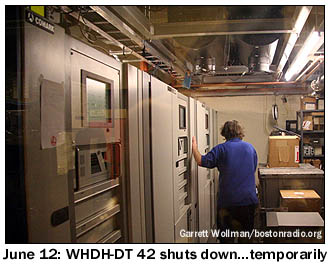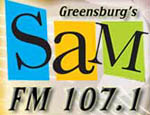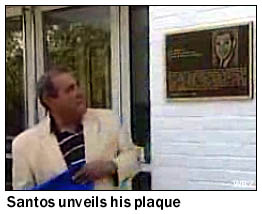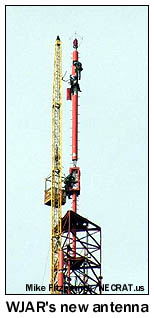|
July 13, 2009
A Month On, DTV Transition Still Tangled
NERW's now on
Twitter - follow us @NERadioWatch for breaking news updates during
the week!
FRIDAY NIGHT UPDATE: With
the death of Walter Cronkite at 92 Friday evening, you'll be
reading plenty of tributes in the hours and days to come. They'll
recognize, properly, the instrumental role Cronkite played in
establishing TV news as a legitimate medium of record. They'll
note his passing just days before the 40th anniversary of one
of his seminal on-air moments, as he became the face and voice
of man's landing on the moon. They'll assess the many ways in
which Cronkite's successors, at CBS and elsewhere, have and have
not lived up to the legacy he left.
But what you probably won't hear is the story of how Walter
Cronkite, at a time when he was at the height of his influence,
did something to help inspire a six-year-old boy with big media
dreams.
The year was 1978, the boy was your editor, and as kindergarten
drew to a close that spring, I was informing (or at least entertaining)
my classmates by doing "newscasts" in front of the
blackboard in the classroom. With six-year-old innocence, and
at least a passing familiarity with the media thanks to an aunt
who worked at the local CBS affiliate, it seemed entirely appropriate
to send one of the scripts from our little kindergarten newscast
to the man whose newscasts we watched over the dinner table every
night.
So off went the letter, explaining - in kindergarten printing,
I'm sure - how much I admired Mr. Cronkite and how I hoped someday
perhaps to take his place behind the anchor desk at CBS.
A week or two went by, and right around the last day of school
I came home to find a fat gray envelope waiting for me, with
the CBS logo in big black print on the left side.
It would have been easy, and entirely reasonable, for the
most famous TV anchorman in the world to have a staffer send
off a form letter, or perhaps even an autographed photo. But
that's not what Walter Cronkite did.
Instead, the fat gray envelope contained this letter, on CBS
stationery, evidently typed by the man himself:
Dear Scott:
That was a fascinating newscast you and Jess and Jeffrey
did on June 10th, and I'm very pleased that you sent me a copy
of your script.
I have a feeling that if you keep up at this pace and get
a good education in school, then one day all three of you will
be at the CBS network.
Sincerely yours,
Walter Cronkite
June 26, 1978
But that wasn't all. In his own handwriting below the typed
letter was this: "P.S. I thought you might like to see
one of our scripts. W.C." And stuffed into that fat
gray envelope was a complete teleprompter roll from those days
before electronic prompters, dozens of pages long, right up to
"And that's the way it is" - the very script that had
rolled in front of Uncle Walter on the night of Tuesday, June
27, 1978.
So know this about Walter Cronkite: the man who told the nation
about JFK and Vietnam and the moon landings and Watergate was
not too big or too self-impressed to take a few minutes to write
back to a starry-eyed kindergartner.
It took nearly twenty years for that six-year-old would-be
newscaster to finally thank Walter Cronkite in person, and by
then there was an interesting irony: having continued on a path
into the news business, inspired in no small part by that letter
back in 1978, your editor ended up at WBZ in Boston. By the time
Cronkite showed up one night in the fall of 1996 to promote his
new book, WBZ's owner, Westinghouse, had acquired CBS - and so
that letter, long ago, that predicted that those kindergarten
newscasters might someday "be at CBS" had come true,
in a way.
Know this, too, about Walter Cronkite: even at the age of
80, he had already lost most of his hearing. So I'm not entirely
sure that he understood - even as I showed him that letter he'd
written me long ago - how much his small gesture back in 1978
meant to me.
So long, Uncle Walter...and thank you.
MORE TUESDAY UPDATES: The
New York Times Company is exiting the radio business after 65
years with the sale of WQXR (96.3 New York). There are two buyers
and a signal shuffle involved: Univision Radio is paying the
Times $33.5 million for the 96.3 signal, and that's where it
will move WCAA (105.9 Newark NJ). The 105.9 signal goes to the
Times, which will then sell that license and the WQXR intellectual
property to public broadcaster WNYC for $11.5 million, making
the total sale price $45 million.
WNYC will operate the new WQXR 105.9 as a noncommercial fulltime
classical station, which will allow WNYC-FM (93.9 New York) to
drop its remaining music programming and run news and information
24/7.
The good news, of course, is that classical WQXR will survive
under committed ownership; the bad news is that listeners in
outlying areas, particularly on Long Island, will have a much
harder time hearing 105.9 (a 600-watt class B1 signal from the
Empire State Building, versus 6000 watts for the full class B
signals on the same master antenna) than they now have with 96.3.
TUESDAY UPDATE: So
long, WBCN! After more than 40 years as a rock station of one
flavor or another, "The Rock of Boston" will cease
to exist August 13, when CBS Radio will move hot AC "Mix"
WBMX from 98.5 to 104.1, relaunching 98.5 as "The Sports
Hub" with new calls WBZ-FM.
The new sports station will bring some big guns to the fight
with Entercom's established sports behemoth, WEEI (850) - it
will have the Patriots play-by-play that's been the most successful
part of WBCN's current programming, as well as the Toucher and
Rich morning show that's now heard on WBCN. The new station will
also be the new home of Bruins hockey, replacing longtime flagship
WBZ (1030), whose contract ended this spring.
We'll have much more on this move in next Monday's NERW...
*Yes, the name of this column is still "NorthEast
Radio Watch," but as we return from our holiday hiatus,
the broadcast news around the region is still very heavily TV-related,
especially at several stations around the region that are breaking
new ground as they try to hang on to their old analog audiences
in the new all-digital era.
Just as it was before the holidays, the spotlight for the
last few weeks has continued to be on the relatively small number
of DTV stations operating on the VHF spectrum - and especially
the handful of big-market stations that made the controversial
choice of a slot on one of the low-band channels, 2 through 6.
In the northeast, that's just two full-power channel 6 signals:
ABC's WPVI in Philadelphia and Freedom's WRGB in Schenectady.
Both stations have already increased power in an attempt to make
up for reception woes they've been experiencing, especially among
viewers using indoor antennas that are generally poorly designed
for low-band VHF signals. But those power increases - to as much
as 30 kW average power, compared with the 10 kW maximum the FCC
had initially imposed for low-band VHF digital in the crowded
northeast - may come at a price for the noncommercial FM stations
whose homes in the 88.1-91.9 MHz band have long been uncomfortable
next-door neighbors to the channel 6 signals occupying 82-88
MHz.
 That
discomfort grew stronger late last week when WRGB made good on
its promises to return an analog audio signal to the air. Like
all analog channel 6 stations, WRGB had an audience around the
region for its audio signal, which was transmitted at 87.75 MHz.
The CBS affiliate already raised some eyebrows prior to the June
12 digital cutover when it revealed that it was seeking experimental
authorization to keep running the audio signal, with vertical
polarization, alongside its horizontally-polarized digital signal. That
discomfort grew stronger late last week when WRGB made good on
its promises to return an analog audio signal to the air. Like
all analog channel 6 stations, WRGB had an audience around the
region for its audio signal, which was transmitted at 87.75 MHz.
The CBS affiliate already raised some eyebrows prior to the June
12 digital cutover when it revealed that it was seeking experimental
authorization to keep running the audio signal, with vertical
polarization, alongside its horizontally-polarized digital signal.
But when the analog audio returned, it had edged up the dial
a bit: it's now at 87.9 MHz, and there are reports that WRGB
has pared back the bandwidth occupied by its digital signal a
bit - possibly as far down as the 5.5 MHz used by several digital
LPTVs on channel 6, such as WNYZ-LP in New York - in order to
alleviate co-channel interference between the digital datastream
and the analog audio.
We've yet to locate WRGB's experimental authorization in the
FCC database, but we'll be watching this story closely to see
what sort of precedent it sets. Will the FCC's rush to pacify
agitated TV broadcasters (and the lawmakers who mandated the
DTV conversion) create new interference to the already densely-packed
noncommercial FM band? For that matter, is the continued provision
of analog audio on channel 6 even legal under the terms of the
law that mandated the digital transition? And in the end, will
the bet made by stations such as WPVI and WRGB - that the lower
power bills on channel 6 would outweigh potential reception issues
- pay off, especially in a DTV world that seems to be moving
toward the mobile services that are only practical on UHF channels?
 *At
least one VHF DTV operator is tacitly acknowledging that it placed
its bets on the wrong band. In Boston, Sunbeam's WHDH-TV (Channel
7) is asking the FCC to modify the DTV table of allocations so
that it can dump its VHF channel in favor of a permanent return
to the transitional UHF channel, 42, that WHDH used for a decade
before moving its digital signal to VHF in June. Even after being
granted a power increase on channel 7, WHDH found the challenges
of indoor reception - especially in areas relatively close to
its tower site in Newton - to be insurmountable. *At
least one VHF DTV operator is tacitly acknowledging that it placed
its bets on the wrong band. In Boston, Sunbeam's WHDH-TV (Channel
7) is asking the FCC to modify the DTV table of allocations so
that it can dump its VHF channel in favor of a permanent return
to the transitional UHF channel, 42, that WHDH used for a decade
before moving its digital signal to VHF in June. Even after being
granted a power increase on channel 7, WHDH found the challenges
of indoor reception - especially in areas relatively close to
its tower site in Newton - to be insurmountable.
Just days after the June 12 cutover, WHDH had asked the FCC
for temporary permission to reactivate the channel 42 facility,
and it's been running both 7 and 42 ever since.
WHDH's situation is an unusually fortunate one: its transitional
digital channel was within the new core (channels 2-51), and
it remained both available and fully spaced after the transition,
providing an easy solution to its VHF troubles, albeit a somewhat
costly one - its channel 42 transmitter is relatively old, as
DTV transmitters go, while its brand-new digital 7 transmitter
will have to be removed and the antenna system atop its tower
reconfigured, assuming the move back to 42 is granted.
For most DTV broadcasters still trying to reach viewers unable
to see their signals, any solutions will come more incrementally,
and more painfully. In Philadelphia, for instance, there are
simply no open UHF channels where WPVI could move, should it
seek to abandon VHF, and the situation is little better in markets
such as New York and Chicago where VHF DTV has been troublesome.
That means the FCC is focusing on other potential technical
improvements, such as the use of circular polarization and beam-tilt
to better reach the areas near transmitter sites that have been
unexpected reception trouble spots. Those solutions aren't cheap,
either, since they require new antennas and more transmitter
power for potentially minimal benefit.
Another somewhat costly solution is already being deployed
by some stations across the region: digital replacement translators,
which the FCC is authorizing on a fairly rapid basis for stations
that have lost coverage with the switch from analog to digital.
In NERW-land, those facilities are still fairly rare: in New
York, WCBS-TV has applied for one on channel 22 in Plainview,
Long Island (the former WLIW-DT transitional facilities), while
Albany's WNYT has applied for translators on 45 in Glens Falls
and 18 in Fort Troy. In Pennsylvania, there are a bunch in and
around Scranton: 36 for WSWB and 47 for WOLF, as well as 25 and
28 in Waymart for WYOU and WBRE, respectively. Johnstown's WJAC
has applied for three: 22 in Altoona, 30 in Bedford and 26 in
Du Bois. And in Pittsburgh, KDKA-TV has applied for 31 in Morgantown,
WV and 40 in Johnstown, while sister station WPCW wants one on
27 in Johnstown.
One more DTV note: Sunday marked the end of the road for the
last remaining analog full-power signals on the U.S. side of
the border, as "nightlight" operation came to an end
at Boston's WGBH-TV, WBZ-TV and WCVB; New York's WCBS-TV; Philadelphia's
KYW-TV and Pittsburgh's KDKA-TV and WTAE. Rochester's WXXI-TV
ended its nightlight operation Friday morning at 10.
*Meanwhile, the financial picture for many smaller TV station
owners isn't getting any clearer, either. Tomorrow the assets
of bankrupt Young Broadcasting will go on the auction block,
including Albany's WTEN/WCDC. But if the reports in the big TV
trades are any indication, there aren't many potential buyers
eyeing Young's stations, even at a bargain price. The company
says it has assets of about $575 million against liabilities
that total just under a billion dollars, and it bears noting
that it was less than a decade ago that Young paid a whopping
$823 million for just one of those stations, KRON in San Francisco.
 And the news about TV news isn't all that bright
this week either, especially if you're in NEW JERSEY,
where whatever was left of the commitment WWOR (Channel 9) made
to the Garden State when it moved to Secaucus from New York City
in the eighties is evaporating still further. Effective tonight,
the Fox-owned station, sister to New York's WNYW (Channel 5),
is no longer competing with the mothership at 10 PM, having cancelled
its nightly "My 9 News at 10" in favor of a half-hour
at 11 PM, with no weekend news at all. Replacing the news in
the 10-11 PM hour on weeknights will be the new Wendy Williams
talk show, which is also being seen weekday mornings at 10 on
WNYW. And the news about TV news isn't all that bright
this week either, especially if you're in NEW JERSEY,
where whatever was left of the commitment WWOR (Channel 9) made
to the Garden State when it moved to Secaucus from New York City
in the eighties is evaporating still further. Effective tonight,
the Fox-owned station, sister to New York's WNYW (Channel 5),
is no longer competing with the mothership at 10 PM, having cancelled
its nightly "My 9 News at 10" in favor of a half-hour
at 11 PM, with no weekend news at all. Replacing the news in
the 10-11 PM hour on weeknights will be the new Wendy Williams
talk show, which is also being seen weekday mornings at 10 on
WNYW.
One more bit of TV news news - New York's WPIX (Channel 11)
is reportedly planning an early-evening newscast, likely at 6:30
PM, to complement its existing morning and 10 PM shows.
In other Garden State news, Rick Brancadora has closed on
his purchase of WILW (94.3 Avalon), clearing the way for the
station to become WIBG-FM any day now...and for Rick to move
ahead on his application to move the station north with an improved
signal over Atlantic City.
Over in Bridgeton, the economy is being blamed for layoffs
at WSNJ (1240), where PD Fred Sharkey and night jock Jonathan
P. Casey are out. Jim Williams replaces Casey at night, while
Brian "Corky" Warren adds PD duties to his sales responsibilities.
And they're mourning Cleo "Don" Brooks, former chairman
of the New Jersey Broadcasters Association and former owner of
several South Jersey stations. Brooks put WTTH (96.1 Margate)
on the air, later adding WBNJ, WDOX, WMID, WZBZ and WSAX to his
group before selling the cluster in 2002. Brooks also programmed
WWIN in Baltimore. He died in late June at age 68.

DO IT RIGHT PRODUCTIONS --
Visit our Web site, doitrightproductions.net,
to hear our three syndicated shows, Classic Clips, Country Roots
and Gospel Doings, produced by longtime country and bluegrass
lovers. We also provide demo and duplicating services. Contact
Roland (Bruce) Cutler, PO Box 351, Lyons, NY 14489; or dirp650@verizon.net.
I'M YOUR GUY! I'm passionate about radio that's a
part of the community and I love meeting listeners because I
TRULY care about being LIVE and LOCAL. With 5 years in radio,
I'm good with technology and I'm just a regular hard working,
honest guy. I'm looking for a radio station to call home. Email
aradiojob@gmail.com
for resume & demos.
You can have
your ad here, for just a few dollars a week! Click
here
for information on the most economical way to reach tens of thousands
of Northeast radio and TV people each week. |
*Back in NEW YORK, we start the week's
news on the Buffalo TV scene, where WIVB (Channel 4) parted ways
with meteorologist Mary Beth Wrobel and reporter Rob Macko last
week. Veteran anchor/reporter Mylous Hairston was also missing
from the Channel 4 airwaves after suffering a heart attack. Hairston
went to the doctor after feeling a tightness in his chest while
anchoring the Sunday night news June 28; he underwent two surgeries
and is expected to be back on the air in a couple of weeks.
In Binghamton, WBNG (Channel 12) general manager Matt Rosenfeld
is off to Granite sister station KSEE in Fresno to serve as president/GM,
and that means a promotion for Greg Catlin, who'd been serving
as VP of news for WBNG. Catlin had also been overseeing the newsroom
at Granite's WTVH in Syracuse until that operation was taken
over by Barrington's WSTM earlier this year.
*Radio news? Yes, there was some of that, too - most notably
in Oneida, where new owner James Johnson is getting ready to
make some changes at WMCR (1600) and WMCR-FM (106.3), including
splitting the longtime simulcast, taking the stations to 24-hour
operation and adding new computer automation behind the scenes.
Judging by the new website at wmcronline.com,
the FM side will stick with music, with an AC format playing
"your favorites from the 80s, 90s and more," while
the AM goes to news and information.
Just down the road in Utica, WRUN (1150) is being sold - or
rather, traded, as Bud Williamson's Digital Radio Broadcasting
acquires the AM signal in trade for translator W247BM (formerly
W248AN) on 97.3 in Cooperstown, plus $20,000. WRUN's current
owner, Albany's WAMC, apparently no longer needs the AM now that
it has WRUN-FM (90.3 Remsen) on the air in the Utica market.
There's a new signal on the air in the hills between the Catskills
and Binghamton along Route 17: WBZX (107.1 Hancock) is now relaying
Scranton's "Rock 107" (WEZX 106.9) into that area,
which means an extra choice in an area that doesn't have much
radio to speak of.
We also noticed a shift in the translator landscape as we
drove home from New York City early last week: W229BH (93.7 Newburgh)
is now relaying religious WNYX (88.1 Montgomery), and it's changed
owners, as Bud Williamson swaps that one to John Katonah in exchange
for W239AC (95.7 Middletown) and W272AV (102.3 Newburgh). If
memory serves, the Middletown translator was relaying WPLJ's
HD2 oldies service as we drove through.
Congratulations to North Country Public Radio (WSLU Canton,
et al) for winning several national Murrow Awards from the RTNDA:
NCPR's "The Impact of War...at Home" won the national
small market Murrow for continuing coverage, while a piece on
"Native Americans in Baseball's Past and Present" won
the Murrow for sports reporting.
VERMONT Public Radio
took home a national Murrow for use of sound in a story called
"Oxen Exam," and down in Harrisburg, PENNSYLVANIA,
WITF won awards for hard news ("Aftermath of the Luis Ramirez
Beating Death") and news series ("Impact of War.")
*More news from the Keystone State: in Pittsburgh, John Tesh
moves from afternoons to nights at WJAS (1320) to make room for
former morning co-host Chris Shovlin, who'll also serve as director
of marketing and promotion for the cluster.
 Meanwhile,
Renda morning newsman Hank Baughman is now working from the company's
Greensburg station, WGSM (107.1), which segues from adult hits
"Sam FM" to classic hits "G-107." Baughman
is still doing morning news for the Pittsburgh stations from
Greensburg, as well as replacing Brent Whigham on WGSM. Meanwhile,
Renda morning newsman Hank Baughman is now working from the company's
Greensburg station, WGSM (107.1), which segues from adult hits
"Sam FM" to classic hits "G-107." Baughman
is still doing morning news for the Pittsburgh stations from
Greensburg, as well as replacing Brent Whigham on WGSM.
Budget cuts at public broadcaster WQED claimed nine jobs last
week, including Dave Rhodes, director of in-studio program and
co-host of "Dave & Dave's Excellent Adventures."
Meanwhile, budget cuts at FSN Pittsburgh meant the end of the
long-running "Savran on Sportsbeat" show, which debuted
on predecessor KBL back in 1991.
Longtime Pittsburgh talker Lynn Cullen is back behind the
mic, doing a daily webcast that starts August 18 on the website
of Pittsburgh's City Paper, which shares ownership with the Steel
City Media radio stations.
Listeners south of Pittsburgh might be hearing a new signal:
WKVE (103.1 Waynesburg) is now testing from its new home in Mount
Pleasant, where it upgrades from class A to B1 with more coverage
into the Uniontown area.
Moving north, Erie-market Christian broadcaster WCTL (106.3
Union City) is adding a relay signal in Youngsville, as it acquires
WTMV (88.5) from Inspiration Time, Inc. for no cash outlay, just
the removal of its equipment and tower.
There's a slogan change on the Pennsylvania border: Youngstown-market
WEXC-FM (107.1 Greenville) has segued from "Freq 107.1"
to "Indie 107.1," reports Ohio
Media Watch, as the station plays up the "rock"
part of its format, though it continues to play some religious
tunes as well.
There's another call change on the New York border: after
a short run with the WLMY calls, the former WFRM-FM (96.7 Coudersport)
changes to WBYB as it prepares to move to Portville, N.Y., in
the Olean market.
In York, Dave Russell is out as PD at WARM-FM (103.3), with
budget cuts to blame.
|
CLEARANCE
SALE! DON'T WAIT!
 We thought we'd sell out of Tower Site Calendar
2009 without resorting to a clearance sale...but
not quite. We thought we'd sell out of Tower Site Calendar
2009 without resorting to a clearance sale...but
not quite.
Our business manager (aka Mrs. Fybush)
reports that a limited quantity of 2009 calendars are still available
- and as we get ready to send Tower Site Calendar 2010
to the printer, we're clearing out the remaining 2009
editions.
The supply is dwindling fast at our clearance
price of just $9 each, postpaid - that's half-off the
usual price of $18. So place that order now - and get ready for
pre-orders of the 2010 edition, starting next week!
Order
now at the fybush.com Store! |
*It was a quiet couple of weeks in eastern
MASSACHUSETTS, unless you were former WBZ sports director
Gil Santos, who became the newest inductee into the WBZ Hall
of Fame on Thursday. Santos, who retired earlier this year, is
the second WBZ veteran to be honored with a plaque outside the
front door of the Soldiers Field Road studios, following longtime
morning partner Gary LaPierre.
 (NERW
wonders who'll be next - surely that honor is overdue for legendary
ex-BZ'ers such as Carl deSuze and Streeter Stuart, not to mention
some more recent names like Maynard, Glick and Brudnoy...) (NERW
wonders who'll be next - surely that honor is overdue for legendary
ex-BZ'ers such as Carl deSuze and Streeter Stuart, not to mention
some more recent names like Maynard, Glick and Brudnoy...)
Over at public radio WBUR-FM (90.9 Boston), news director
John Davidow has been shifted to a new position as executive
editor of the WBUR.org website, while Martha Little, late of
the now-defunct NPR show "Day to Day," joins WBUR as
news director. General manager Paul LaCamera says the website,
which is now "under reconstruction," will relaunch
later this summer with the goal of challenging the Globe's boston.com
and WCVB's thebostonchannel.com as major online news players
in the Boston market.
In Worcester, public station WICN (90.5) wants to move its
transmitter site from Stiles Hill in Boylston (the WUNI-TV tower)
to Mount Asnebumskit in Paxton. The proposed move would come
with a significant power decrease (from 8.1 kW to 1.1 kW) but
an even more significant increase in height (from 371' to 810'),
taking advantage of Asnebumskit's commanding line of sight over
much of central Massachusetts to improve WICN's signal over central
and western Worcester County. And yes, we're well aware of the
irony - Entercom's WAAF (107.3 Westborough) abandoned WICN's
future home, the old Armstrong tower on Asnebumskit, to make
the reverse move to Stiles Hill a couple of years ago.
Out west, WBSL (91.7 Sheffield) is now rebroadcasting
community station WHDD-FM (91.9 Sharon, CONNECTICUT) when
the Berkshire School isn't originating its own programming on
91.7. Local WBSL programming is heard during school sessions
from 7-8 AM and 7-11 PM on weekdays and from 7-11 on Saturday
nights; the rest of the time, it's now a WHDD simulcast, significantly
extending that new station's reach to the north.
 Two
new callsigns: Mercysong's 91.9 in Stockbridge will be WDMY,
while Light of Life Ministries' new 91.5 in Rockport will be
WWRN. Two
new callsigns: Mercysong's 91.9 in Stockbridge will be WDMY,
while Light of Life Ministries' new 91.5 in Rockport will be
WWRN.
*Light of Life has new calls for its new
signals in MAINE, too: 91.5 in Fryeburg will be WFYB,
while 91.7 in Ellsworth will be WRNM.
*DTV reception in RHODE ISLAND could
soon get a little better: WJAR (Channel 10/RF 51) is in the process
of replacing its side-mounted antenna with a new top-mounted
antenna in the space where the old channel 10 analog antenna
used to be.
We're indebted to our colleague Mike Fitzpatrick for passing
along photos of the work going on at WJAR's site in Rehoboth,
Mass. - and remember to look for his NECRAT tower photos at their
new web address, www.necrat.us!
And while we're on the subject of WJAR, the station is celebrating
its 60th anniversary this month, complete with a website,
an anniversary special that aired last Friday, and memories from
viewers celebrating their own anniversaries this July.
 Edited by NERW's own Scott Fybush - on sale now as
an e-book or printed volume!
Edited by NERW's own Scott Fybush - on sale now as
an e-book or printed volume!
*News about the TV business dominated the
headlines out of CANADA last week, too, with one station
sale announced, another proposed sale cancelled, and at least
some interim indications of the CRTC's future policy directions
for local TV.
 The
newly-announced sale will take CHCH (Channel 11) in Hamilton
and CJNT (Channel 62) in Montreal off the hands of CanWest Global,
which has been trying to shed what it says are unprofitable operations
at those "E!"-branded stations. The new owners of those
stations will be Channel Zero, Inc., which is best known now
for its specialty cable channels, including Movieola and Silver
Screen Classics. No purchase price was announced for the deal,
which Channel Zero says will transform CHCH into a news service
by day, with movies at night. The
newly-announced sale will take CHCH (Channel 11) in Hamilton
and CJNT (Channel 62) in Montreal off the hands of CanWest Global,
which has been trying to shed what it says are unprofitable operations
at those "E!"-branded stations. The new owners of those
stations will be Channel Zero, Inc., which is best known now
for its specialty cable channels, including Movieola and Silver
Screen Classics. No purchase price was announced for the deal,
which Channel Zero says will transform CHCH into a news service
by day, with movies at night.
Meanwhile, Shaw Communications has backed away from its audacious
offer to buy CKNX-TV (Channel 8) in Wingham, CHWI-TV (Channels
16/60) in Wheatley/Windsor and CKX-TV in Brandon, Manitoba from
CTV for a dollar. Shaw's not saying why it won't pursue that
deal.
In the meantime, though, the CRTC is issuing short-term license
renewals to English-language local TV outlets across Canada in
order to keep them on the air through the summer of 2010 while
the agency formulates a comprehensive new strategy for commercial
TV. Under the terms of the renewals, CKNX-TV will become a full-time
relay transmitter for London's CFPL-TV (Channel 10), which has
been providing the bulk of its programming anyway. The new short-term
licenses also do away with two "regional" licenses
that had barred Global from selling local advertising in Toronto
and Montreal. Under the new licenses, Global's CIII-TV-41 (Channel
41) in Toronto will become its primary station for Ontario, while
CKMI-TV-1 (Channel 46) in Montreal will take over from CKMI-TV
(Channel 20) in Quebec City as the primary station for that province.
*On the radio dial, Evanov Communications is expanding its
Ontario footprint west to Brantford, with the proposed acquisition
of CKPC (1380) and CKPC-FM (92.1). Those Telephone City Broadcast
Ltd. stations have been in limbo since owner Richard Buchanan
died in January 2008. No purchase price has been announced for
that sale, either.
"The addition of the Brantford stations will play a critical
role on our expansion plans for the future," said Evanov
president Bill Evanov in a statement announcing the deal. "We
are both excited and eager to serve Brantford”.
 Over
in St. Catharines, troubled CHSC (1220) got slapped again by
the CRTC last week. The station has been in the agency's crosshairs
for several years, and now the CRTC has issued "mandatory
orders" compelling the Pellpropco-owned station to broadcast
in English to the Niagara Region instead of in Italian to Toronto
on weekday mornings, to maintain logger tapes, and to comply
with CanCon requirements. The CRTC warns that it could take more
drastic steps - including license revocation - if CHSC doesn't
come into compliance. Over
in St. Catharines, troubled CHSC (1220) got slapped again by
the CRTC last week. The station has been in the agency's crosshairs
for several years, and now the CRTC has issued "mandatory
orders" compelling the Pellpropco-owned station to broadcast
in English to the Niagara Region instead of in Italian to Toronto
on weekday mornings, to maintain logger tapes, and to comply
with CanCon requirements. The CRTC warns that it could take more
drastic steps - including license revocation - if CHSC doesn't
come into compliance.
In Woodstock, Ontario, CIHR (104.7) has been granted a power
increase - from an average ERP of 1.9 kW to 7.1 kW - over the
objections of broadcasters in neighboring London and Tillsonburg,
who complained that Byrnes Communications' "Heart FM"
would create new competition in those markets.
In Peterborough, silent CKKK (90.5) is changing hands: Andy
McNabb is buying the station from King's Kids Promotions Outreach
Ministries, Inc. for $160,000, retaining its religious format.
And we close this week's column on a sad note: longtime CFNY
(102.1 Toronto) jock Martin Streek, who was let go from the station
in the midst of budget cutbacks in May, was found dead in his
home last Monday (July 6), an apparent suicide. Streek was 45.
|
From
the NERW Archives
(Yup, we've been doing this a long time now, and
so we're digging back into the vaults for a look at what NERW
was covering one, five, ten and - where available - fifteen years
ago this week, or thereabouts. Note that the column appeared
on an erratic schedule in its earliest years as "New England
Radio Watch," and didn't go to a regular weekly schedule
until 1997. Thanks to LARadio.com
for the idea - and thanks to you, our readers, for the support
that's made all these years of NERW possible!)
July 14, 2008 -
- Central NEW JERSEY is a tough place to operate a local AM
station these days, up against a dial full of FM signals from
within the state and neighboring New York and Philadelphia, not
to mention a plethora of other entertainment and information
choices. So it was probably only a matter of time before Greater
Media pulled the plug on most of the local programming at news-talker
WCTC (1450 New Brunswick) and oldies WMTR (1250 Morristown).
That day arrived July 2, as both stations flipped to satellite
"Good Time Oldies," with only separate local morning
shows remaining to provide some sort of local identity.
- At WCTC, the format flip kept veteran jock Jack Ellery in
the morning chair, once again playing the music that was a station
trademark before it switched to talk, but it ousted afternoon
talker Alan David Stein, middayer Lauren Pressley and a mid-morning
block of financial and food talk. At WMTR, the move to satellite
oldies knocked out local jocks MK Dombrowski and the "Golden
Gup," Robert Gascoigne, who minced no words when he told
the Star-Ledger, "Radio has become a waste of electricity."
WMTR's local voice-tracked part-timers, including Mark Mitchell
and Pete Tauriello, are also out, but at least they're able to
keep their day jobs - Tauriello, for instance, is the morning
traffic voice on WINS (1010 New York). Chris Edwards stays on
board doing mornings at WMTR.
- The biggest news out of PENNSYLVANIA over the last couple
of weeks came from the State College area, where veteran station
owner Cary Simpson handed over the keys to WGMR (101.1 Tyrone)
to Forever on July 7, bringing an end to the station's many decades
under those call letters, most recently with top 40 as "G101."
To nobody's surprise (but lots of chatter on the message boards),
Forever promptly flipped the station to country as "Froggy,"
using its big class B signal to give that regional brand new
reach in the areas north and east of Forever's other Froggy stations
in the area, WFGY (98.1 Altoona) and WFGI-FM (95.5 Johnstown).
The WGMR calls are gone from 101.1, too, replaced at week's end
by WFGE.
- Froggy's former home in State College, WSGY (98.7 Pleasant
Gap), was silent for a few days as its ownership transferred
from Forever to 2510 Licenses, but it returned July 9 with adult
contemporary music as "Wish," with new calls WWSH.
- One of the true veterans of NEW HAMPSHIRE radio has retired.
Paul Leblanc spent a remarkable 44 years at WTSN (1270 Dover),
pretty much all that time as morning man. (His arrival at the
station came right on the heels of the departure of a talented
young newsman named Gary LaPierre; there must have been something
in the water up there in the early sixties.) Leblanc's last "WTSN
Morning Information Center" broadcast on July 11 was followed
that evening by a big retirement dinner at the Great Bay Gallery
in Somersworth, where Leblanc was honored with a "WTSN Lifetime
Achievement Award" and a big-screen TV. General manager
Mike Dafoe tells Foster's Daily Democrat that he hopes LeBlanc
will return for some fill-in work down the road - and LeBlanc
tells the paper he plans "to do a whole lot of nothing."
- Just after our last issue before our holiday break came out,
there was a format change in VERMONT: Northeast Broadcasting's
WUSX (93.7 Addison) dropped its "US Country" format,
which never made a dent in market behemoth WOKO (98.9 Burlington),
in favor of oldies and a new nickname, "Cruisin' 93.7."
- In Syracuse, WSYR-TV (Channel 9) reporter Mike Price retired
July 3 after an amazing 45-year run at the station, all the way
back to its genesis as WNYS-TV in the basement of Shoppingtown
Mall way back when. Price was a staff announcer back then, best
remembered for his portrayal of "Baron Daemon," host
of horror movies late at night and the kiddie cartoons in the
afternoon. (He even boasts the top-selling local record in Syracuse
music history, the 1963 novelty tune "Transylvania Twist.")
After a 1967 studio fire that destroyed his costumes and sets,
Baron Daemon was retired, and Price became an audio operator
and then a general-assignment reporter for Channel 9. More recently,
he's been contributing "Good News" segments to the
station's evening newscasts. Price says he's hoping to continue
to do some voiceover and freelance work in his retirement.
July 12, 2004 -
- When we headed out on the road two weeks ago for the first
of several bits of summer travel, we were already hearing rumblings
about a big announcement from the Howard Stern camp - and sure
enough, a few days after we departed for Colorado, Howard announced
nine new affiliates, including replacements in Pittsburgh and
Rochester where his former Clear Channel affiliates dropped his
show back in February.
- And in western PENNSYLVANIA, Stern's arrival on an Infinity-owned
FM meant the demise of one of Pittsburgh's longest-running formats.
Admittedly, the top 40 at WBZZ (93.7 Pittsburgh) had taken a
beating in recent years as the station reinvented itself, first
replacing "B94" with "93-7BZZ" and then with
"B93-7." The 23 years of heritage CHR came to an end
June 30, when B gave way to "K-Rock," with new calls
of WRKZ following a few days later and Stern's arrival scheduled
for July 19. (And yes, WRKZ is itself something of a heritage
Keystone State callsign, but not to Pittsburgh ears - it was
over in the Harrisburg market for most of the last two decades.)
- The "Dave, Bubba and Shelly" morning show that
was a 93.7 staple is gone, as are several other jocks at the
former WBZZ calls - and the calls themselves were quickly packed
in dry ice and driven out the Parkway West to be flown down to
Tampa for another new Stern affiliate, "1010 the Buzz,"
the former WQYK (1010 Seffner FL).
- And at the other end of the Keystone State, Radio One modified
its application to move WSNJ-FM (107.7 Bridgeton) to 107.9 in
Pennsauken, NEW JERSEY. Instead of the current CP, which calls
for 1900 watts at 156 meters above average terrain on the WKDN
(106.9 Camden NJ) tower in Camden, Radio One now wants to put
WSNJ-FM right in the heart of Philadelphia - as in, two blocks
from William Penn's statue atop City Hall. The new application
for WSNJ-FM's 107.9 facility calls for 550 watts at 252 meters
from the very same One Liberty Plaza skyscraper that's already
home to WMMR (93.3 Philadelphia). Radio One has also applied
for Special Temporary Authority for WSNJ-FM, presumably to allow
the station to remain silent while it pursues this modified move
in to Philadelphia.
- Oldies have returned to the Ogdensburg area with the flip
of AC "Yes FM" WYSX (98.7 Ogdensburg) to "PAC
98-7" WPAC. "Yes FM" sticks around on the simulcast
frequency of 96.7, by way of a strange little swap of facilities.
Grab a pencil, a piece of paper and a couple of Advils and try
to follow along: The class A facility that was WNCQ (102.9 Morristown)
upgrades to class C3, changes frequency to 96.7 and takes on
the calls WYSX and the "Yes FM" AC format. The class
A facility that was WPAC (96.7 Canton) moves to 102.9, changes
calls to WNCQ and picks up the "Q Country" that's been
on WNCQ 102.9 all along anyway. If this makes sense to you, you're
probably an FCC lawyer; for the average listener in the North
Country, the practical result is that "Q Country" more
or less stays put on 102.9 (just changing its ID from Morristown
to Canton) and "Yes" more or less stays put on 96.7,
albeit with a power increase and a new Morristown city of license.
- All of which brings us to a series of swaps that should be
a little bit easier to understand: right on schedule at midnight
July 4, Clear Channel flipped active rocker WNVE (95.1 Honeoye
Falls) to classic hits as WFXF, "the Fox," moving WNVE's
"Nerve" format up the dial - and down in power - to
the former WFXF (107.3 South Bristol) facility. The Nerve led
into the change with repeated spins of Nirvana's "Smells
Like Teen Spirit," while the Fox showed a bit more creativity,
leaving 107.3 behind with a playlist that included Bowie's "Changes,"
the Who's "Song is Over," the Eagles' "Already
Gone," Bob Seger's "Night Moves" (it was a midnight
swap, after all), Billy Joel's "Movin; Out," the Beatles'
"Hello, Goodbye" and finally Genesis' "Follow
You, Follow Me" (which cut off partway through, but now
we're just being picky.)
- So far, so good, right? Leave it to the local paper (the
Rochester Democrat and Chronicle, which has now officially replaced
the Boston Globe as this column's favorite example of one-stop-beyond-clueless
radio reporting) to confuse matters. First came the "news"
article, more than a week after even the slowest of the radio
trades had reported the switch, almost two weeks after WFXF began
promoting it on air and - yup - even a day after WFXF finally
gave up waiting for a news article and took out an ad announcing
the move, that somehow wound up with the claim that neither station
would be using any live jocks - which had to have been a shocker
for the live jocks who were (and still are) on the Nerve.
July 16, 1999 -
- The student voice of Colby College is silent for the moment,
as staffers of WMHB (90.5 Waterville) try to find out why their
station has no current license in FCC records. The FCC still
lists WMHB at its old 91.5 frequency, which the station vacated
in the mid-80s to allow Maine Public Broadcasting to put WMEW
on the air at 91.3 in Waterville. So how does MPBC repay the
favor a decade later? The statewide public broadcaster applied
back in January for a 90.5 transmitter in Camden, on the coast
southeast of Waterville and mutually exclusive with the 90.5
facilities WMHB has been using for years. The FCC deadline for
competing applications for 90.5 is Monday night, July 19, and
thus far, MPBC's application is the only one.
- The students who run WMHB tell the Central Maine Morning
Sentinel that they never received the warning MPBC claims it
gave Colby about the problem. In the meantime, they took WMHB
off the air last Saturday (July 10) while they try to resolve
the problem. Ironically, MPBC is funded in part by Colby College,
thanks to the merger of the former MPBN network and WCBB-TV Lewiston,
which was owned by Colby, Bates, and Bowdoin Colleges. (2009 update: This one had a happy ending, as
MPBC helped WMHB find a new home down the dial at 89.7.)
- Moving west to NEW HAMPSHIRE, Dennis Jackson checked in to
report his WZEN (106.5 Farmington) is now operating 24 hours
a day with its "real" format as "Oldies 106.5."
The station is running in mono for better coverage, and using
Portsmouth and Winnipesaukee in its IDs. Sign-on was last Friday
(July 9) at 10 PM.
- From RHODE ISLAND this week, we have two station sales that
really are, and one that's not. The real ones are the Urso family's
last Bear Broadcasting properties, WADK (1540) Newport and WERI-FM
(99.3) Block Island. They're being sold, for a reported $1.8
million, to Maurice Polayes' Astro Tele-Communications of Needham,
MA. Polayes is promising no changes to WADK's talk-and-jazz format
and WERI-FM's AAA format, but we'll wait and see, thanks.
- Now for the one that wasn't quite so: NERW was startled to
find a notice in last week's issue of Broadcasting & Cable
that Brown Broadcasting's WBRU (95.5 Providence) was being sold
to Chancellor for all of $2 million. Not only did the price seem
absurdly low for a class B signal in the Providence market, but
we found it hard to believe Brown would have any reason to sell
a station it's owned for half a century, or that B&C would
list a sale long before it appeared in the FCC database or any
of the on-line trade publications (which usually scoop B&C
by a week or two).
- Sure enough, we find next Monday's B&C will carry a correction
indicating that such a sale is not, in fact, taking place. Could
a company like Chancellor (now AMFM, Inc.) get a station like
WBRU? Maybe, but we suspect the price would be more like $20
million than $2 million. Providence listeners will have to wait
a while longer for "Jammin' Oldies," we guess...
You
can sponsor this weekly feature! Click here for information! |
NorthEast Radio Watch is made possible by the generous
contributions of our regular readers. If you enjoy NERW, please
click here to
learn how you can help make continued publication possible. NERW
is copyright
2009 by Scott Fybush. |






